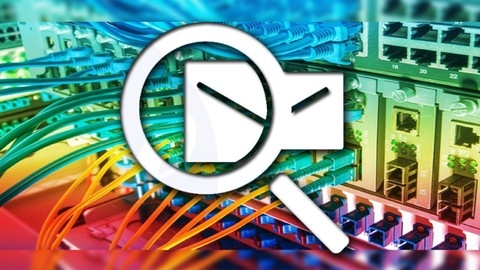Packet Tracer is a powerful tool that simulates real-world network environments, making it an invaluable asset for aspiring network engineers.
Learning Packet Tracer equips you with the practical skills needed to configure routers, switches, and other networking devices, troubleshoot common issues, and ultimately gain a deeper understanding of how networks function.
However, navigating the vast selection of Packet Tracer courses on Udemy can be overwhelming, leaving you unsure which one is right for you.
You want a course that’s comprehensive, engaging, and taught by experts, with a focus on hands-on labs to reinforce your understanding.
For the best Packet Tracer course overall on Udemy, we recommend Cisco CCNA Packet Tracer Ultimate labs: CCNA 200-301 labs.
This course stands out for its emphasis on practical experience, covering a wide range of lab scenarios and essential CCNA topics like subnetting, DHCP, VLANs, and routing protocols.
You’ll not only learn how to configure networks but also gain valuable troubleshooting skills, preparing you for the real-world challenges of a networking career.
While this is our top pick, we’ve also curated a list of other exceptional Packet Tracer courses on Udemy, catering to different skill levels and learning goals.
Keep reading to discover the perfect course for your networking journey.
Cisco CCNA Packet Tracer Ultimate labs: CCNA 200-301 labs
With a focus on labs and practical exercises, you’ll gain valuable experience configuring and troubleshooting networks using Cisco’s Packet Tracer software.
One of the standout features is the wide range of lab scenarios included.
You’ll start with basic network setups and progress to more complex topologies, covering essential CCNA topics like subnetting, DHCP, VLANs, Spanning Tree, access lists, NAT, and routing protocols like OSPF and EIGRP.
The course even touches on advanced areas like wireless networking, voice over IP, and quality of service.
Throughout the labs, you’ll learn practical skills like setting passwords, backing up configurations, password recovery, and restoring IOS images.
You’ll also dive into technologies like NTP, Syslog, SNMP, AAA, TACACS, and RADIUS for network management and security.
Instead of just memorizing concepts, you’ll get hands-on practice configuring routers and switches, troubleshooting common issues, and understanding how networks function behind the scenes.
This practical approach will prepare you for the real-world scenarios you’ll encounter in the CCNA exam and as a networking professional.
With the importance of networking in today’s world, driven by the growth of the Internet, social media platforms like Facebook and Snapchat, and the rise of the Internet of Things, this course equips you with valuable skills for an in-demand career path.
You’ll learn how networks enable communication and access to websites like Google and YouTube, which have become integral to modern life.
Cisco CCNA 200-301 Complete Course: Packet Tracer Labs
This comprehensive course covers everything you need to know for the Cisco CCNA 200-301 certification exam.
You will start by learning the fundamentals of networking and progress through advanced topics like routing protocols, network security, voice over IP, cloud computing, and network programmability.
The course is extremely hands-on, with numerous Packet Tracer labs that allow you to practice configuring and troubleshooting networks.
You’ll learn how to set up VLANs, spanning tree, EtherChannel, HSRP, DHCP, ACLs, NAT, quality of service, and more on real Cisco equipment.
The instructor also demonstrates hacking techniques and how to secure your network against threats.
For routing, you’ll dive deep into static routing, OSPF, EIGRP, and IPv6 addressing.
There are modules dedicated to WAN technologies like PPP, Frame Relay, VPNs, and GRE tunnels.
You’ll get exposed to advanced topics like Cisco DNACenter APIs, Python scripting, JSON, and Linux on IOS.
The course comes with tons of supplementary material like videos explaining troubleshooting scenarios, cheat sheets from PacketLife.net, and documentation on relevant RFCs.
With such comprehensive coverage and a heavy hands-on focus, this course will thoroughly prepare you for the challenging CCNA exam while making you an expert in configuring Cisco networks.
Practical Cisco Networking Labs in Cisco Packet Tracer
You’ll start with an introduction to Packet Tracer itself, then dive into VLANs and the Spanning-Tree Protocol (STP).
The course explores STP security measures to prevent attacks.
Moving on, you’ll learn routing protocols like RIP, OSPF, EIGRP, and BGP through hands-on exercises.
Frame Relay is also covered, including point-to-point and multipoint configurations.
Advanced OSPF concepts like multiple areas, authentication, virtual links, and summarization are included.
The course doesn’t stop at routing – you’ll also configure Network Address Translation (NAT) and access lists (standard and extended).
The highlight is the Superlab, where you’ll create a complex topology and configure IP addressing, DHCP, NAT, routing protocols, BGP, redistribution, and access lists.
Additional topics like HSRP for router redundancy, Layer 3 EtherChannel, Point-to-Point Protocol (PPP), VoIP, IPsec VPNs, and GRE tunnels are covered as bonus sections.
Cisco CCNA 200-301 Configuration Labs
You will learn how to configure routers and switches using Packet Tracer exercises.
The course starts with basic router and switch configuration, covering essential topics like IPv6 interface configuration and port modes on switches.
As you progress, you’ll dive into more advanced networking concepts like VLANs, port security, and inter-VLAN routing.
The course covers static routing configuration, preparing you for dynamic routing protocols like OSPF, OSPFv3, and EIGRP.
You’ll also learn how to configure access control lists for network security.
The syllabus includes crucial topics like VTP, spanning-tree, and Etherchannel configuration, ensuring you have a well-rounded understanding of switch operations.
Additionally, you’ll learn about eBGP configuration and HSRP for redundancy and load balancing.
Throughout the course, you’ll work with Packet Tracer exercises, allowing you to practice your skills in a simulated environment.
Cisco CCENT Packet Tracer Ultimate labs: ICND1 Exam prep lab
This course offers extensive hands-on labs to prepare you for the CCNA (ICND1 100-105) exam, which is a highly sought-after networking certification.
With numerous topologies and scenarios, you’ll gain practical experience in configuring and troubleshooting Cisco networks.
You’ll start by mastering basic commands and understanding how packets traverse networks.
Then, you’ll dive into subnetting, DHCP server configuration, VLANs, and advanced campus network setups involving features like PortFast, EtherChannel, and HSRP.
The course also covers crucial topics like access lists, NAT, password recovery, IOS backup/restore, and protocol implementation (RIP, EIGRP, OSPFv3).
The instructor, David Bombal, is a CCIE with over 15 years of experience training engineers at Fortune 100 companies.
With his expertise and the course’s comprehensive labs, you’ll gain the confidence to discuss networking concepts, configure devices like routers and switches, and ultimately pass the CCNA exam.
You’ll learn how networks enable critical services like Facebook, Google, and understand networking’s role in emerging technologies like IoT.
With no prerequisites, it’s an excellent entry point into this in-demand field.
Cisco CCNA Packet Tracer Ultimate labs: ICND2 Exam prep labs
This course is packed with hands-on labs to help you gain practical experience for the CCNA exam.
You’ll get access to a wealth of Packet Tracer labs covering everything from basic VLAN configuration to advanced BGP troubleshooting scenarios.
The course starts with fundamental networking concepts like VLANs, VTP, and Spanning Tree.
You’ll learn how to configure and troubleshoot these technologies through interactive labs.
As you progress, you’ll tackle more advanced topics like EIGRP, OSPF, BGP, IPv6, and even VoIP with Cisco IP Phones.
One of the highlights is the extensive BGP coverage, with multiple labs walking you through configuring and troubleshooting BGP networks.
You’ll also dive into security technologies like ACLs, AAA with RADIUS/TACACS, and DHCP snooping.
The labs are designed to mirror real-world scenarios you might encounter as a network engineer.
For example, you’ll learn how to configure QoS policies, set up GRE tunnels, and even deploy a Wireless LAN Controller.
Throughout the course, the instructor provides guidance and solutions to each lab, ensuring you understand not just the configurations but also the underlying concepts.
With such a comprehensive set of labs, you’ll gain the confidence to handle any CCNA exam question that tests your practical networking skills.
Basics of Cisco Packet Tracer Network Simulator for CCNA
The course begins with an introduction to Packet Tracer itself, explaining what it is and how to join the online classroom.
You’ll then dive into choosing and adding different network devices like PCs, servers, routers, and switches.
The course teaches you about the various connection types and cables used to interconnect these devices.
You’ll even learn how to add custom interfaces and connect wireless devices.
Once you have your network set up, the real fun begins with device configuration.
You’ll start with basic PC and server setups before moving on to routers and switches.
For these network devices, you’ll learn both basic and advanced configuration using the command-line interface (CLI).
A key feature of Packet Tracer is the ability to track packets in real-time or simulation mode.
This course covers both, allowing you to visualize how data flows through your simulated networks.
Throughout the course, you’ll have opportunities to apply what you’ve learned with hands-on Packet Tracer labs.
These labs let you build and configure networks yourself, solidifying your understanding of the concepts.
The Ultimate Cisco CCNA Packet Tracer Project
You start by designing the network topology and configuring the main site, including setting up VLANs, EtherChannel trunks, and redundancy with HSRP.
As you progress, you’ll handle inter-VLAN routing, configure servers’ IP settings, and ensure connectivity within the main site.
The course then guides you through setting up branch offices, implementing Frame-Relay and PPP connections, and configuring DHCP for the branches.
You’ll dive into advanced topics like port security, rapid spanning tree, PortFast, BPDU guard, and access control lists (ACLs) for enhanced security.
Internet connectivity is established by configuring DHCP pool, default routing, and web access ACLs on the ISP router.
Network Address Translation (NAT) and Port Address Translation (PAT) are implemented to provide Internet access for internal users.
You’ll also configure external DNS and static PAT entries.
Throughout the course, you’ll work with real-world scenarios, mastering essential networking concepts like VLANs, routing, DHCP, Frame-Relay, and security features like ACLs and port security.
Cisco Packet Tracer CCNA 200-301 Labs Adventure 1
You’ll start by diving into VLANs and VTP, learning how to configure them on switches.
This segues into router-on-a-stick and switch virtual interface (SVI) setups for inter-VLAN routing.
Spanning Tree Protocol takes center stage next, with hands-on practice configuring STP, RSTP, and PortFast on switches to prevent loops.
You’ll also explore EtherChannel for link aggregation and CDP for gathering device information.
Moving on, you’ll tackle essential services like NAT (static, dynamic, and PAT) for IP address translation and DHCP for automatic host configuration.
The course even covers advanced DHCP features like DHCP Relay.
For wide area networks, you’ll get experience configuring PPP, HDLC, and the powerful Multi-Link PPP for bonding multiple links.
Verifying MLPPP operation is also included.
Throughout the course, you’ll use Packet Tracer to gain practical experience applying these technologies in simulated networks.
The hands-on labs reinforce concepts and prepare you for real-world scenarios.
With its broad scope covering VLANs, routing, security, WAN, and services, this course equips you with valuable skills for networking roles.
Cisco Packet Tracer Network Simulator Introduction
You’ll start by learning what Packet Tracer is and how to navigate its graphical user interface (GUI).
From there, you’ll dive into the workspace and build your first logical Layer 2 lab, setting it up and configuring end user devices.
The course then guides you through capturing packets, an essential skill for network analysis.
You’ll move on to building a logical Layer 3 lab, setting it up and configuring base routers.
Along the way, you’ll continue honing your packet capturing abilities.
But the learning doesn’t stop there.
You’ll also explore working with physical topology in Packet Tracer, getting hands-on experience in the physical topology workspace.
And if you’re interested in the Internet of Things (IoT), you’re in luck - the course includes a dedicated IoT mini lab where you’ll build and configure an IoT lab environment.










